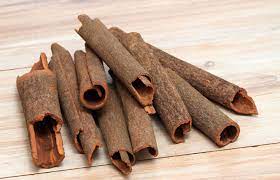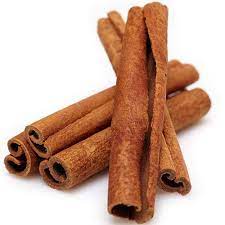Cinnamon bark refers to the outer bark of the Cinnamomum tree, particularly from species such as Cinnamomum verum (true or Ceylon cinnamon) and Cinnamomum cassia (cassia cinnamon). It is a popular spice known for its distinctive sweet and warm flavor, making it a common ingredient in both sweet and savory dishes.
Cinnamon bark is obtained by peeling the outer bark from the tree and allowing it to dry. The dried bark curls into the characteristic cinnamon sticks or quills that are used for culinary and medicinal purposes.
Cinnamon has been used for centuries in traditional medicine and as a culinary spice. It is believed to have various health benefits, including anti-inflammatory, antioxidant, and antimicrobial properties. Some studies suggest that cinnamon may help in managing blood sugar levels, improving heart health, and aiding in digestion.
When using cinnamon in cooking, it can be ground into a powder and added to dishes such as desserts, curries, stews, and beverages. Additionally, cinnamon sticks can be used to infuse flavors into hot beverages like tea or mulled wine.

The Economic Importance and Uses of Cinnamon Bark
Cinnamon bark, derived from the Cinnamomum tree, is a popular spice known for its distinct flavor and aroma. It has significant economic importance and various uses, both in the culinary and non-culinary sectors.
Here are the economic importance and uses of cinnamon bark:
1. Flavoring Agent: Cinnamon bark is a widely used spice in cooking and baking, imparting a sweet and warm flavor to a variety of dishes, including desserts, curries, stews, and beverages.
2. Traditional Medicine: Cinnamon has been used in traditional medicine for its potential health benefits, including anti-inflammatory, antimicrobial, and antioxidant properties. It is believed to aid digestion and support blood sugar control.
3. Essential Oils: Cinnamon bark is used to extract essential oil, which is utilized in aromatherapy and natural medicine for its potential health-promoting properties.
4. Active Compounds: Cinnamon bark contains bioactive compounds like cinnamaldehyde, cinnamic acid, and cinnamate, which are of interest to the pharmaceutical industry for potential medicinal applications.
5. Fragrance and Aroma: Cinnamon bark and its essential oil are used in cosmetics, perfumes, and personal care products to provide a pleasant fragrance and aroma.
6. Spice Blends and Mixes: Cinnamon bark is a key ingredient in various spice blends and mixes used in the food industry to enhance the flavor and aroma of different products, including spice rubs, sauces, and condiments.
7. Beverages: Cinnamon is used to flavor a range of beverages, such as teas, coffees, hot chocolates, and cocktails.
8. Antimicrobial Properties: Cinnamon bark and its extracts have antimicrobial properties, making them useful for food preservation and extending the shelf life of certain food products.
9. Pastry and Desserts: Cinnamon bark is a common ingredient in baking, particularly in pastries, cookies, cakes, and pies, where it adds a unique flavor and fragrance.
10. Aromatic Properties: Cinnamon bark is used in the production of incense and aromatherapy products due to its pleasant and comforting aroma.
11. Decorative Use: Cinnamon sticks made from the bark are often used in floral arrangements, potpourri, and decorative crafts due to their appealing appearance and fragrance.
Read Also: Cocoyam Roots: Economic Importance, Uses, and By-Products
12. Economic Value: Cinnamon bark is a valuable export commodity, contributing to the economies of countries that produce and export it. Sri Lanka, Indonesia, China, Vietnam, and India are major exporters of cinnamon.
The Products and By-products That Can Be Derived From Cinnamon Bark

Cinnamon bark is a versatile spice obtained from the bark of several species of trees in the Cinnamomum genus. It is known for its distinct flavor and aroma, making it a popular ingredient in various cuisines and traditional medicines.
Here are the products and by-products that can be derived from cinnamon bark:
1. Cinnamon Powder: Cinnamon powder is the most common product derived from cinnamon bark. The bark is ground into a fine powder, which is widely used as a spice in cooking and baking.
Cinnamon Oil: Cinnamon bark can be steam-distilled to obtain cinnamon essential oil. This oil is highly concentrated and has various applications, including in aromatherapy, flavoring, and fragrance.
2. Cinnamon Extract: Cinnamon extract is obtained by extracting the active compounds from cinnamon bark using a solvent. The resulting concentrated liquid is used in food flavoring, dietary supplements, and traditional medicine.
3. Cinnamon Capsules/Tablets: Cinnamon extract can be encapsulated or pressed into tablets for easier consumption. These forms are commonly used in dietary supplements and herbal remedies.
4. Cinnamon Tea: Dried cinnamon bark or cinnamon powder can be used to make cinnamon tea. The tea is made by steeping the bark or powder in hot water and is enjoyed for its taste and potential health benefits.
5. Cinnamon Sticks: Cinnamon sticks are whole pieces of dried cinnamon bark, often used to infuse flavor into beverages and dishes during cooking.
6. Cinnamon Syrup: Cinnamon syrup is made by combining cinnamon powder or extract with sugar and water. It’s used as a sweetener and flavoring agent in beverages, desserts, and cocktails.
7. Cinnamon Flavored Liquor: Cinnamon bark can be used to infuse flavors into alcoholic beverages like whiskey or vodka, creating cinnamon-flavored liquor.
8. Cinnamon in Cosmetics: Cinnamon extract or oil is utilized in cosmetic products such as lotions, creams, and soaps due to its aromatic properties and potential skin benefits.
9. Cinnamon Incense: Cinnamon bark can be used to produce incense sticks or cones, adding a pleasant aroma to the environment during burning.
10. Cinnamon Bark Mulch: Cinnamon bark can be processed into mulch, which is used for landscaping and gardening to retain moisture and suppress weeds.
11. Cinnamon Bark Charcoal: The bark can be carbonized to produce charcoal, which has various applications, including as a fuel source and for art and craft purposes.
In conclusion, it is important to note that there are different types of cinnamon, with Ceylon cinnamon being considered the “true” or “real” cinnamon, while cassia cinnamon is more commonly found and has a stronger, more pungent flavor. Both types have similar health benefits but differ in taste and the presence of certain compounds.
Read Also: What Can I Do With An Agriculture Degree?

